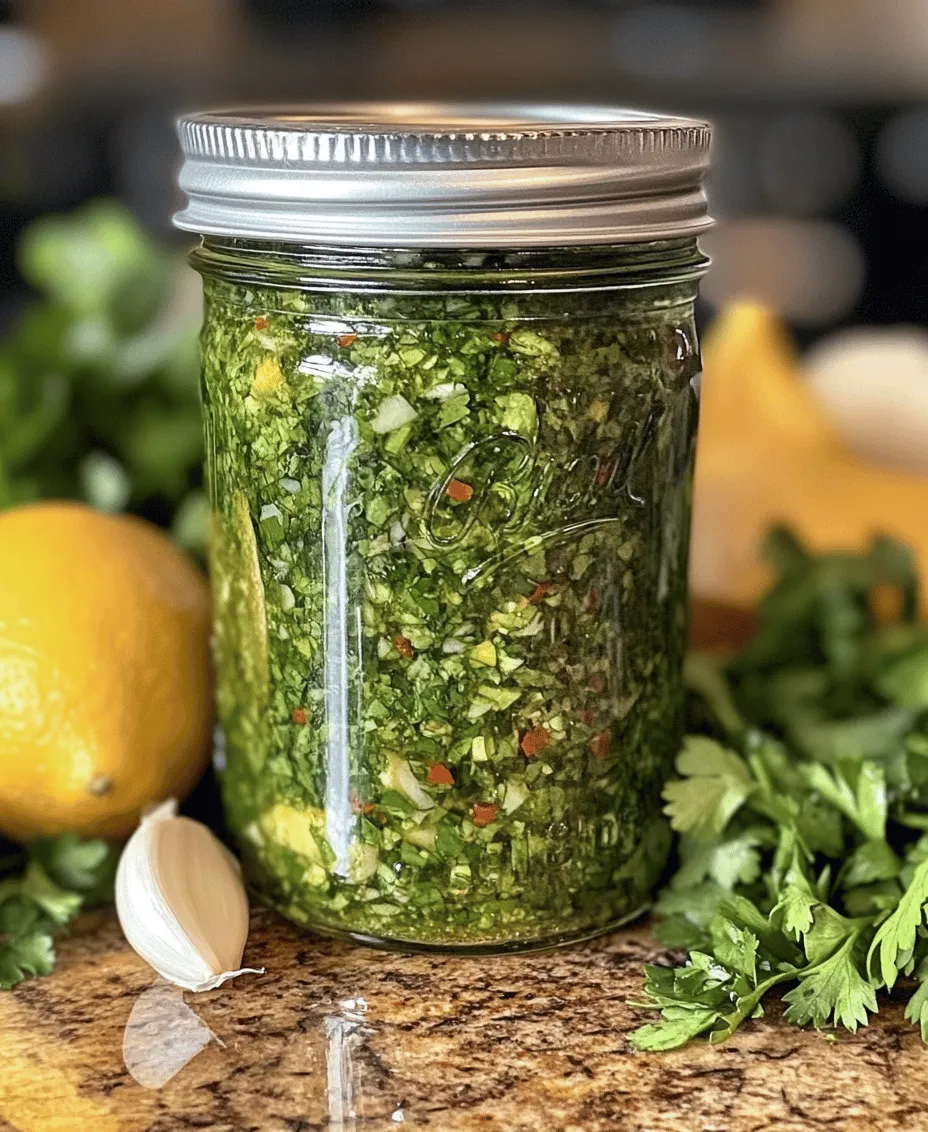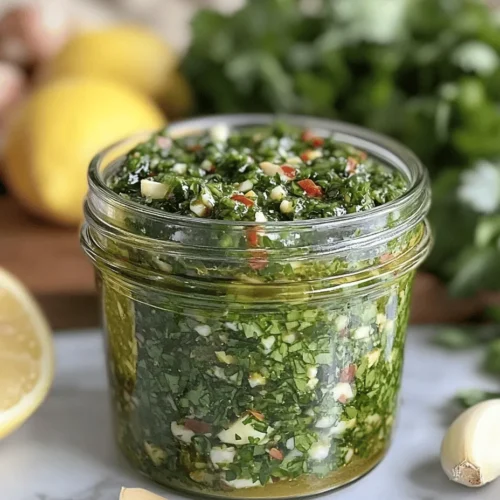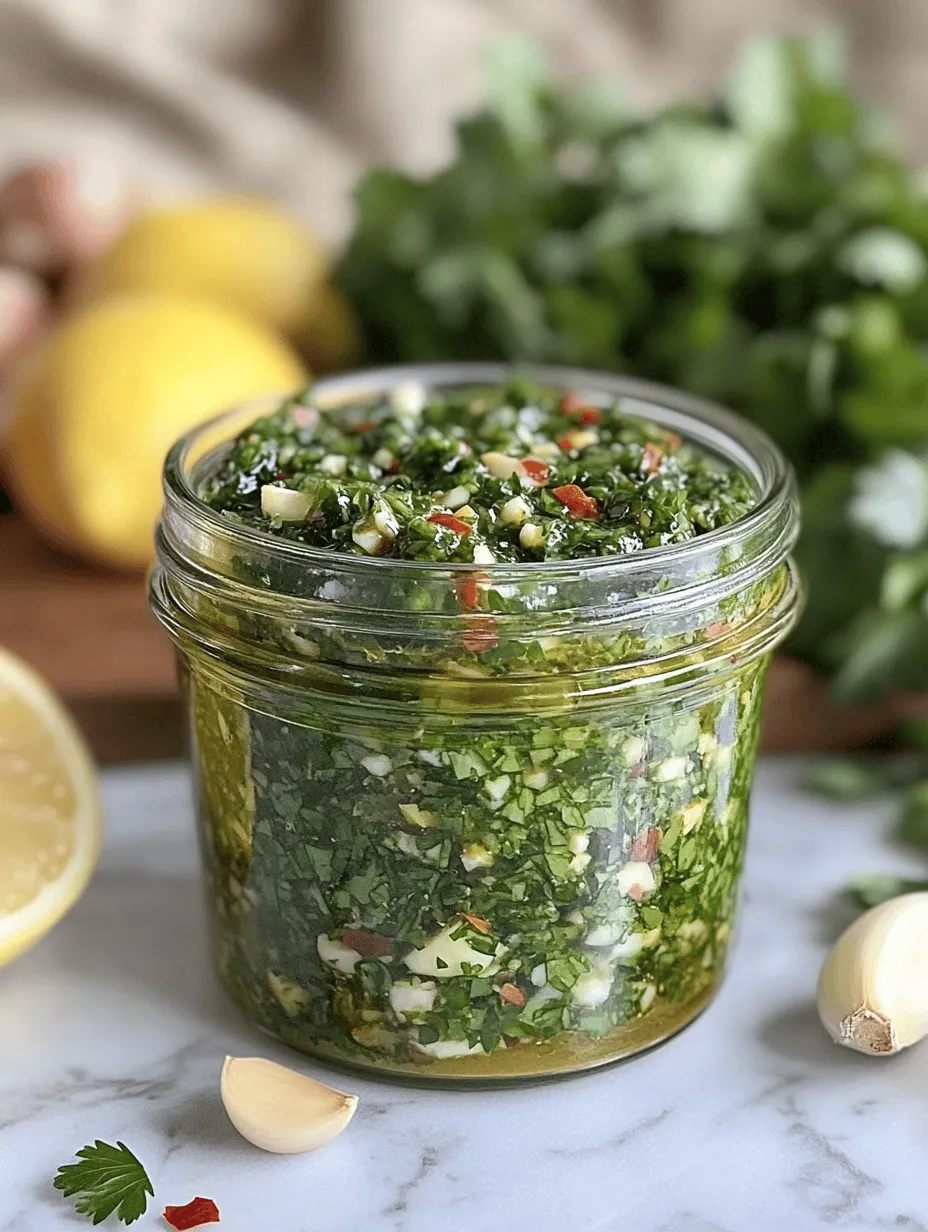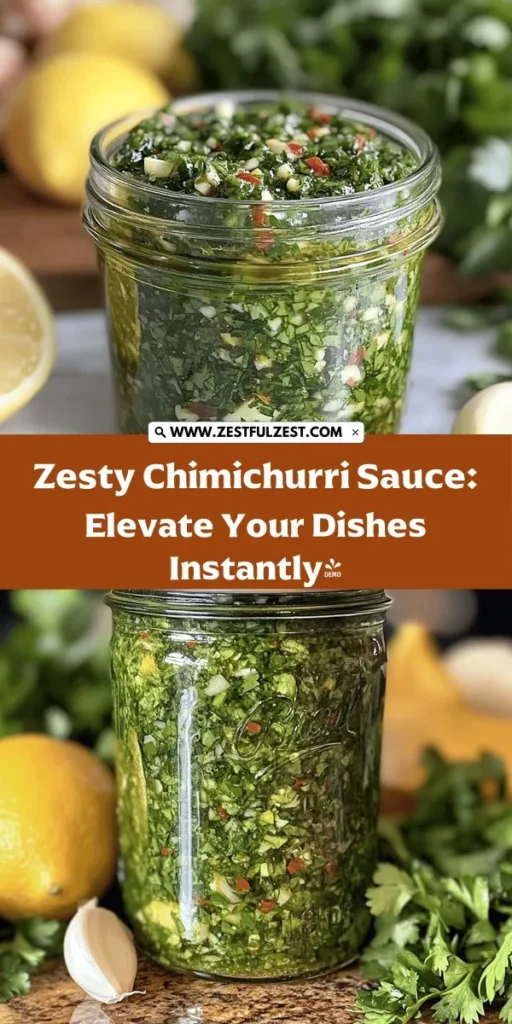Introduction
Chimichurri sauce is a vibrant, herbaceous condiment that hails from Argentina, often regarded as a staple in Argentine cuisine. This versatile sauce is typically made from fresh parsley, garlic, vinegar, olive oil, and a hint of red pepper flakes, creating a zesty flavor explosion that enhances a variety of dishes. Whether you’re drizzling it over grilled meats, tossing it with roasted vegetables, or using it as a marinade, chimichurri adds a burst of freshness that elevates your culinary experience.
The significance of fresh ingredients cannot be overstated when it comes to crafting this sauce. Homemade chimichurri allows you to control the flavors and avoid the preservatives often found in store-bought options. With just a few simple ingredients, you can create a sauce that is not only delicious but also packed with health benefits, making it a must-have in any kitchen.
Understanding Chimichurri
Chimichurri’s Argentine origins trace back to the 19th century when it was used as a marinade for grilled meats, particularly the renowned Argentine asado, or barbecue. This sauce embodies the essence of Argentine cuisine—simple yet bold flavors that celebrate the freshness of local ingredients. Traditionally, chimichurri is served alongside grilled steaks, but its uses have expanded globally, inspiring numerous variations that cater to different palates.
While the classic version remains a favorite, variations of chimichurri can be found in many regions, each bringing its unique twist to this beloved sauce. For instance, some variations incorporate herbs such as oregano or mint, while others experiment with different types of vinegar or citrus fruits. Despite these adaptations, the core elements of chimichurri—herbs, acidity, and spice—remain consistent.
The beauty of chimichurri lies in its balanced flavor profile. The freshness of the herbs complements the acidity of the vinegar, while the garlic adds depth and aroma. The red pepper flakes provide a subtle heat that can be adjusted according to personal preference, making this sauce adaptable to various dishes and occasions.
Ingredients Breakdown
To create a mouthwatering chimichurri sauce, it’s essential to select high-quality, fresh ingredients. Let’s delve into the primary components that make this sauce a standout:
Fresh Parsley and Cilantro
The backbone of any chimichurri is the fresh herbs, predominantly parsley and cilantro. Parsley is known for its vibrant green color and slightly peppery flavor, while cilantro adds a bright, citrusy note. Both herbs are rich in vitamins A, C, and K, as well as antioxidants, making them not only flavorful but also beneficial for health. When combined, they create a refreshing herbaceous base that is crucial for a well-rounded chimichurri.
Red Wine Vinegar
Red wine vinegar plays a pivotal role in chimichurri, providing the necessary acidity to balance the richness of the olive oil. Its tangy flavor enhances the overall taste of the sauce, adding depth and complexity. Opting for high-quality red wine vinegar can significantly elevate your chimichurri, as it will impart a more pronounced and nuanced flavor.
Garlic
Garlic is the aromatic powerhouse of chimichurri, lending its robust flavor and health benefits to the sauce. Known for its anti-inflammatory and immune-boosting properties, garlic enhances the taste profile of chimichurri while contributing to its health benefits. Fresh garlic is recommended for optimal flavor; however, if you prefer a milder taste, you can adjust the quantity to suit your palate.
Red Pepper Flakes
The inclusion of red pepper flakes adds a touch of heat to the chimichurri, allowing you to tailor the spiciness to your liking. From a gentle warmth to a more pronounced kick, the amount of red pepper flakes can easily be adjusted. This flexibility makes chimichurri a versatile condiment that can cater to diverse taste preferences.
Olive Oil
Quality matters when it comes to olive oil, as it forms the base of the sauce. A good extra virgin olive oil will not only enhance the flavor of chimichurri but also contribute healthy fats to your diet. Look for olive oils with a rich, fruity flavor profile to ensure your chimichurri is both delicious and healthful.
Lemon Juice
Lastly, a squeeze of lemon juice adds a refreshing brightness to the sauce, further enhancing its flavor complexity. The acidity from the lemon juice complements the vinegar and rounds out the overall taste of chimichurri.
Step-by-Step Preparation
Now that you have a solid understanding of the ingredients, let’s dive into the preparation process. Making chimichurri is straightforward and requires minimal culinary skills. Follow these detailed steps to ensure your sauce is packed with flavor:
Finely Chopping Herbs
1. Select Fresh Herbs: Start with a generous bunch of fresh parsley and cilantro. Ensure the herbs are vibrant and free from wilting or browning.
2. Rinse and Dry: Rinse the herbs under cold water to remove any dirt or impurities. Use a salad spinner or pat them dry with a clean kitchen towel to ensure they’re not too wet.
3. Remove Stems: Strip the leaves from the thick stems of the parsley and cilantro. While tender stems can be used, avoid the woody parts that may affect the texture of the sauce.
4. Chop Finely: Using a sharp chef’s knife, gather the leaves together and chop them finely. The goal is to release the essential oils and flavors from the herbs, so don’t rush this step. A fine chop will ensure a well-blended sauce.
Mincing Garlic
1. Peel the Garlic: For this recipe, you’ll need 2-4 cloves of fresh garlic. Start by removing the outer skin and peeling the cloves.
2. Crush and Chop: Place the flat side of your knife on a garlic clove and apply pressure to crush it slightly. This will make it easier to chop. Once crushed, finely mince the garlic until you achieve a paste-like consistency. This technique helps release the natural oils, amplifying the garlic flavor in the finished sauce.
3. Combine Ingredients: In a mixing bowl, combine the finely chopped parsley and cilantro with the minced garlic. Stir them together gently to combine the flavors before adding the remaining ingredients.
Assembling the Sauce
Once you have your herbs and garlic prepared, it’s time to combine all the ingredients and create your zesty chimichurri sauce. In the next steps, you’ll learn how to incorporate the vinegar, olive oil, and other components to complete this delightful condiment.
Mixing the Sauce
1. Add Vinegar: Pour in the red wine vinegar, adjusting the quantity based on your taste preference. Start with 2 tablespoons and add more if you desire a tangier sauce.
2. Incorporate Olive Oil: Gradually drizzle in the extra virgin olive oil while stirring. A good rule of thumb is to use about ½ cup, but feel free to adjust this based on how rich you want the sauce to be.
3. Season with Spice and Citrus: Add red pepper flakes to taste, starting with a pinch and increasing if you prefer a spicier sauce. Finally, squeeze in fresh lemon juice to brighten the flavors.
4. Mix Thoroughly: Stir everything together until well combined. Allow the chimichurri to rest for at least 15-30 minutes before serving. This resting period allows the flavors to meld, resulting in a more harmonious sauce.
By following these steps, you’ll create a zesty homemade chimichurri sauce that captures the essence of Argentine cuisine and elevates any dish it accompanies. The combination of fresh herbs, vibrant acidity, and balanced spice will make this sauce a cherished addition to your culinary repertoire. In the next part of this article, we will explore further tips for best results, serving suggestions, and answer some common questions about chimichurri sauce. Stay tuned for the continuation of this flavorful journey!

The Importance of Mixing the Ingredients in the Right Order for Optimal Emulsification
When making chimichurri sauce, the order in which you mix the ingredients is vital for achieving the best texture and flavor. Start by finely chopping your herbs, particularly the parsley and cilantro, as they form the base of the sauce. The key to a well-emulsified chimichurri is to ensure that the herbs are finely minced. This allows them to release their essential oils, enhancing the overall flavor profile.
Next, add the garlic, which should also be minced to ensure it evenly distributes throughout the sauce. This step is important because garlic can be quite potent; too much in one bite can overpower the chimichurri, while even distribution allows for balanced flavor.
After combining the herbs and garlic, slowly drizzle in the olive oil while stirring continuously. This gradual incorporation of oil helps to emulsify the sauce, creating a cohesive mixture that binds the flavors together. Follow this with the vinegar and spices, mixing well after each addition to ensure that every component is thoroughly combined. The result should be a vibrant, aromatic chimichurri that clings beautifully to your grilled meats and vegetables.
Tips for Achieving the Perfect Consistency in Chimichurri
Achieving the perfect consistency in chimichurri is all about balance. Ideally, chimichurri should be somewhat thick yet pourable, allowing it to coat your dishes without being too runny. Here are some essential tips to help you reach that ideal texture:
1. Adjust the Oil: If your chimichurri is too thick, gradually add more olive oil until it reaches your desired consistency. Conversely, if it’s too thin, you can add more herbs or a bit of bread crumbs to thicken it up.
2. Herb Proportions: The ratio of herbs to oil is crucial. A good starting point is a 1:1 ratio of chopped herbs to oil. Adjust this based on your preference for a stronger herb flavor or a richer sauce.
3. Chop Finely: The finer you chop your herbs and garlic, the smoother your chimichurri will be. A processor can help, but be cautious not to over-blend; you want a bit of texture for that rustic feel.
4. Resting Time: Allowing your chimichurri to sit at room temperature for at least 30 minutes after mixing will help the flavors meld and develop. This resting period not only enhances the overall taste but also impacts the texture by allowing the oil to soak into the herbs.
Insight into the Resting Period: Why It’s Crucial for Flavor Development
The resting period is an often-overlooked step in sauce preparation but is essential in allowing the flavors to meld and intensify. For chimichurri, letting it sit for a minimum of 30 minutes at room temperature, or up to several hours, allows the garlic and herbs to infuse the oil and vinegar with their robust flavors.
During this time, the fresh herbs release their oils, and the vinegar’s acidity begins to soften the raw edge of the garlic, producing a more harmonious flavor profile. If you can, prepare your chimichurri a few hours ahead of serving, or even the day before. This time allows the sauce to develop deeper, richer flavors, making it a perfect complement to any dish.
Serving Suggestions
Chimichurri is incredibly versatile and can elevate a variety of dishes. Here are some top serving suggestions to make the most out of this vibrant sauce:
– Pairing with Grilled Meats: Chimichurri is traditionally served with grilled meats, particularly beef. Cuts like flank steak, ribeye, or skirt steak are ideal as their robust flavors complement the zesty sauce. Chicken and pork also benefit from chimichurri’s fresh acidity, providing a delightful contrast to the meat’s richness.
– Marinade vs. Finishing Sauce: You can use chimichurri as both a marinade and a finishing sauce. As a marinade, it infuses meats with flavor before cooking, making them juicy and aromatic. Alternatively, use it as a finishing sauce to drizzle over grilled meats just before serving, allowing its fresh flavors to shine.
– Creative Uses: Beyond meats, chimichurri can brighten up roasted vegetables, adding a burst of freshness. Drizzle it over warm veggies right after cooking for an added layer of flavor. It’s also fantastic in sandwiches, providing a zesty spread that enhances everything from turkey to veggie wraps.
– Elevating Ordinary Dishes: Even simple dishes can be transformed with chimichurri. Use it as a dipping sauce for bread, a flavor booster for rice, or a topping for grilled fish. The possibilities are endless, and its vibrant taste can turn an ordinary meal into something extraordinary.
Storage and Shelf Life
To maintain the freshness and flavor of your homemade chimichurri, it’s essential to store it properly:
1. Proper Storage Methods: Store chimichurri in an airtight container in the refrigerator. Glass jars work well, as they don’t retain odors and can be easily cleaned. Make sure to press plastic wrap directly against the surface of the sauce before sealing the container to minimize air exposure.
2. Understanding Shelf Life: Homemade chimichurri can last in the fridge for about one week. If you notice any changes in color or smell, it’s best to discard it to avoid consuming spoiled sauce.
3. Signs of Spoilage: Look out for changes in texture or color, such as browning of the herbs or an off smell. If you notice any separation of ingredients or a sour odor, it’s an indication that the chimichurri has gone bad.
Nutritional Information
Homemade chimichurri is not just flavorful; it also offers several nutritional benefits:
– Calories and Fats: A standard serving of chimichurri (about one tablespoon) contains approximately 40 calories, primarily from healthy fats in the olive oil. The fat content is beneficial as it aids in the absorption of fat-soluble vitamins.
– Vitamins and Minerals: The fresh herbs in chimichurri contribute a range of vitamins, including vitamin K from parsley and antioxidants from garlic. Olive oil, a key ingredient, is rich in heart-healthy monounsaturated fats.
– Health Benefits: The ingredients in chimichurri are known for their health benefits, including anti-inflammatory properties from olive oil and garlic, which may help support heart health. Additionally, chimichurri can fit into various dietary preferences—being naturally vegan, gluten-free, and low-carb, making it a suitable choice for many.
Conclusion
Homemade chimichurri sauce is a vibrant, flavorful addition to any kitchen. Its zesty profile and versatility make it an exceptional condiment that can elevate a variety of dishes, from grilled meats to roasted vegetables. The process of creating your chimichurri allows for personal touches—whether that’s adjusting the herbs, spices, or oil—to truly make it your own.
Experimenting with this recipe not only enhances your culinary repertoire but also brings the joy of homemade sauces into your meals. As you explore different serving options and flavor combinations, you’ll discover the endless possibilities that chimichurri offers, enriching your dining experience and impressing your family and friends. Embrace the art of making your sauces, and enjoy the flavorful journey that awaits!



